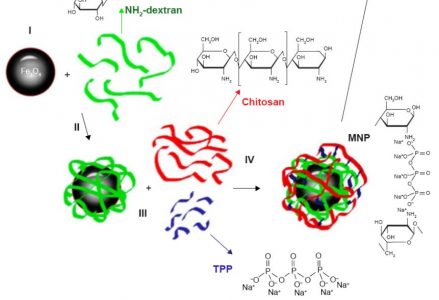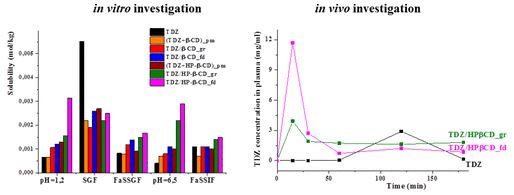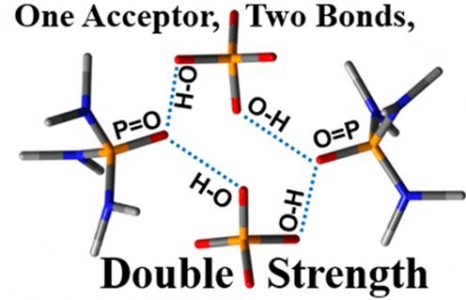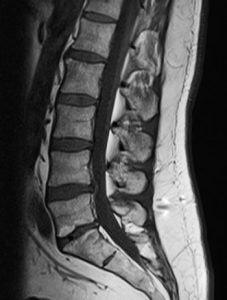 Ранее, 22.06.2016, мы приводили объективные доказательства существования головного мозга у директора РЦ МРМИ. Сегодня мы спешим поделиться новой информацией: директор не бесхребетный (см. картинку). Анализ приведенного изображения трактуется специалистами как признаки существования у пациента позвоночника, что позволило классифицировать его как представителя типа Chordata. В дальнейшем коллектив центра постарается установить, откуда у директора растут руки.
Ранее, 22.06.2016, мы приводили объективные доказательства существования головного мозга у директора РЦ МРМИ. Сегодня мы спешим поделиться новой информацией: директор не бесхребетный (см. картинку). Анализ приведенного изображения трактуется специалистами как признаки существования у пациента позвоночника, что позволило классифицировать его как представителя типа Chordata. В дальнейшем коллектив центра постарается установить, откуда у директора растут руки.
Tag Archive for Толстой
Хордовые
Int. J. Nanomedicine, 2018, 1471-1482
M. Shevtsov, B. Nikolaev, Y. Marchenko, L. Yakovleva, N.V. Skvorzov, A. Mazur, P. Tolstoy, V. Ryzhov, G. Multhoff
“Targeting experimental orthotopic glioblastoma with chitosan-based superparamagnetic iron oxide nanoparticles (CS-DX-SPIONs)”
Int. J. Nanomedicine, 2018, 13, 1471-1482
DOI: 10.2147/IJN.S152461
Glioblastoma is the most devastating primary brain tumor of the central nervous system in adults. Magnetic nanocarriers may help not only for a targeted delivery of chemotherapeutic agents into the tumor site but also provide contrast enhancing properties for diagnostics using magnetic resonance imaging (MRI)
ACS Biomater. Sci. Eng, 2018, 491-501
M. Promzeleva, T.V. Volkova, A.N. Proshin, O.I. Siluykov, A. Mazur, P.M. Tolstoy, S.P. Ivanov, F. Kamilov, I.V. Terekhova
“Improved biopharmaceutical properties of oral formulations of 1,2,4-thiadiazole derivative with cyclodextrins: in vitro and in vivo evaluation”
ACS Biomater. Sci. Eng, 2018, 4(2), 491-501
DOI: 10.1021/acsbiomaterials.7b00887
The synthesized 1,2,4-thiadiazole derivative displaying biological activity has low aqueous solubility and dissolution rate. Novel oral formulations of thiadiazole with β- and hydroxypropyl-β-cyclodextrins were obtained by grinding and freeze-drying methods with the purpose to improve the aqueous solubility. Complex formation of 1,2,4-thiadiazole derivative with cyclodextrins was confirmed by means of solid-state 13C MAS CP/TOSS NMR. Solubility, dissolution rate and permeability of the solid inclusion complexes were evaluated in different biorelevant media (SGF, FaSSGF, FaSSIF) simulating the conditions in the gastrointestinal tract. It was demonstrated that the content of biorelevant media affects the properties of the inclusion complexes. In particular, solubilizing effect of cyclodextrins became less pronounced when the micelles of taurocholic acid and lecithin are formed in the dissolution media. The inclusion of thiadiazole into cyclodextrin cavity is in competition with its partitioning into the micelles and this should be taken into account when the in vivo behavior is predicted. The results of in vitro and in vivo experiments were found to be in agreement and showed the highest solubility, dissolution rate and bioavailability of the freeze-dried complexes of thiadiazole with hydroxypropyl-β-cyclodextrin. These complexes can be proposed as more effective dosage forms for oral administration.
J. Phys. Chem. C, 2018, 1711-1720
E.Yu. Tupikina, M. Bodensteiner, P.M. Tolstoy, G.S. Denisov, I.G. Shenderovich
“P=O Moiety as an Ambidextrous Hydrogen Bond Acceptor”
J. Phys. Chem. C, 2018, 122(3), 1711-1720
DOI: 10.1021/acs.jpcc.7b11299
Hydrogen bond patterns of crystals of phosphinic, phosphonic, and phosphoric acids and their cocrystals with phosphine oxides were studied using 31P NMR and single-crystal X-ray diffraction. Two main factors govern these patterns and favor or prevent the formation of cocrystals. The first one is a high proton-accepting ability of the P═O moiety in these acids. As a result, this moiety effectively competes with other proton acceptors for hydrogen bonding. For example, this moiety is a stronger proton acceptor than the C═O moiety of carboxylic acids. The second factor is the inclination of the P═O moiety of both the acids and the oxides to form two hydrogen bonds at once. The peculiarity of these bonds is that they weaken each other to a little degree only. In order to highlight this point, we are using the term “ambidextrous”. These two features should govern the interactions of P═O moiety with water and other proton donors and acceptors in molecular clusters, the active sites of enzymes, soft matter, and at surfaces.
Spinus 2018
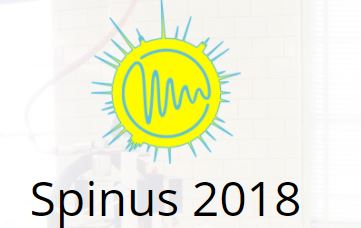 С 1 по 6 апреля прошла очередная 15 школа-конференция Spinus 2018. Приятно отметить, что многие пользователи рц МРМИ и, собственно, сами сотрудники приняли активное участие в этой конференции. Среди сотрудников участвовали: М.А. Вовк, С.И. Сухаржеский, П.М. Толстой, А.С. Мазур. Среди пользователей рц МРМИ: В.И. Чижик, И.С. Гиба, А.В. Иевлев, М. Костин, Д.А. Лузик, Д.А. Маркелов, В.В. Малоярова, А.В. Пенькова, С.О. Рабдано, В. Барнаускайте.
С 1 по 6 апреля прошла очередная 15 школа-конференция Spinus 2018. Приятно отметить, что многие пользователи рц МРМИ и, собственно, сами сотрудники приняли активное участие в этой конференции. Среди сотрудников участвовали: М.А. Вовк, С.И. Сухаржеский, П.М. Толстой, А.С. Мазур. Среди пользователей рц МРМИ: В.И. Чижик, И.С. Гиба, А.В. Иевлев, М. Костин, Д.А. Лузик, Д.А. Маркелов, В.В. Малоярова, А.В. Пенькова, С.О. Рабдано, В. Барнаускайте.
Мы надеемся, что в будущем интерес к конференции Spinus среди пользователей рц МРМИ будет возрастать, и молодые исследователи будут активно апробировать свои работы и представлять их широкому кругу коллег.
Phys. Chem. Chem. Phys., 2018, 4901-4910
V.V. Mulloyarova, I.S. Giba, M.A. Kostin, G.S. Denisov, I.G. Shenderovich, P.M. Tolstoy
“Cyclic Trimers of Phosphinic Acids in Polar Aprotic Solvent: Symmetry, Chirality and H/D Isotope Effects on NMR Chemical Shifts”
Phys. Chem. Chem. Phys., 2018, 20, 4901-4910
DOI: 10.1039/C7CP08130H
The hydrogen-bonded self-associates of dimethylphosphinic (1), diphenylphosphoric (2), phenylphosphinic (3), and bis(2,4,4-trimethylpentyl)phosphinic (4) acids have been studied by using liquid-state NMR down to 100 K in a low-freezing polar solvent, CDF3/CDClF2. The H/D isotope effects on 1H NMR chemical shifts caused by partial deuteration of hydroxyl groups unambiguously reveal the stoichiometry of the self-associates and the cooperativity of their hydrogen bonds. In all cases, cyclic trimers are the dominant form, while cyclic dimers are present as a minor form for 1 and 2. Due to the asymmetry of substituents, cyclic trimers of 3 exist in two isomeric forms, depending on the orientation of the phenyl groups with respect to the plane of the hydrogen bonds. The racemic mixture of 4 leads to the coexistence of up to 64 isomers of cyclic trimers, many of which are chemically equivalent or effectively isochronous. The mole fractions of such isomers deviate from the statistically expected values. This feature could provide information about the relative stabilization energies of hydrogen-bonded chiral self-associates. The complexation of 4 with SbCl5 (complex 5) suppresses the self-association and 5 exists exclusively in the monomeric form with chemically non-equivalent 31P nuclei in RS, SR and RR/SS forms
J. Polym. Sci. A, 2018, 387-398
V.A. Rozentsvet, O.A. Stotskaya, V.P. Ivanova, M.G. Kuznetsova, P.M. Tolstoy, S.V. Kostjuk
“Structural characterization of polybutadiene synthesized via cationic mechanism”
J. Polym. Sci. A, 2018, 56, 387-398
DOI: 10.1002/pola.28905

The microstructure of polybutadiene synthesized via cationic polymerization using TiCl4‐based initiating systems has been investigated using 1D (1Н, 2Н, and 13С) and 2D (HSQC and HMBC) NMR spectroscopy. It was found that trans‐1,4‐unit is predominant structure of unsaturated part of polymer chain. Besides, the small amount of 1,2‐structures was also detected, while cis‐1,4‐units were totally absent. The signals of carbon atoms of three types of head groups (trans‐1,4‐, 1,2‐, and tert‐butyl) and two types of end groups (trans‐1,4‐Cl and 1,2‐Cl) were identified for the first time in macromolecules of cationic polybutadiene. It was showed that tert‐butyl head groups were formed due to the presence in monomer of admixtures of isobutylene. The new methodology for calculation of the content of different structural units in polybutadiene chain as well as the head and end groups was proposed. It was established that main part of 1,2‐units distributed randomly along the polybutadiene chain as separate units between trans‐1,4‐structures.
FIRST
П.М. Толстой провел занятие на тему «ЯМР систем с водородной связью» для студентов бакалавриата и магистратуры университета Ювяскюля (Финляндия) в рамках русско-финского студенческого семинара по программе обмена FIRST. Программа мероприятий в Институте химии СПбГУ.
Турнир школьников
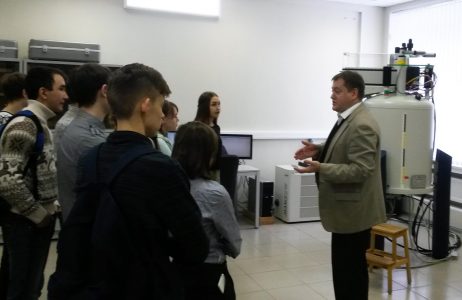
Ресурсный центр МРМИ посетили участники Всероссийского химического турнира школьников. П.М. Толстой провел демонстрацию оборудования и рассказал нашим гостям о возможностях современных магнитно-резонансных методов исследования, реализованных в рц.
Лекция
22.02.18 в актовом зале школы №20 Санкт-Петербурга прошла открытая лекция директора ресурсного центра «Магнитно-резонансные методы исследования» П.М. Толстого «Достижения физической химии». В лекции было рассказано о наиболее значимых для повседневной жизни человека открытиях последних лет в области химии, физики, материаловедения. После лекции общение с учащимися продолжилось в форме беседы о перспективах обучения в Санкт-Петербургском университете по специальностям «Физика» и «Химия».
